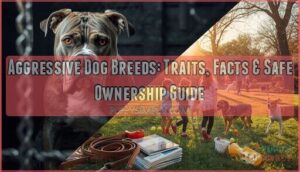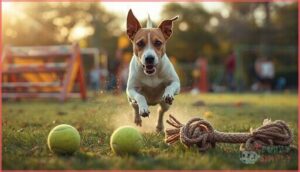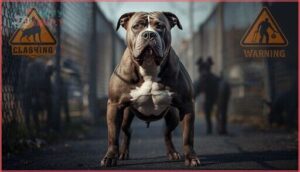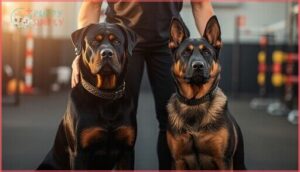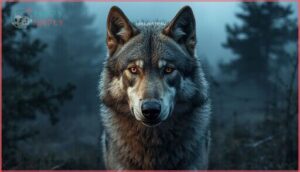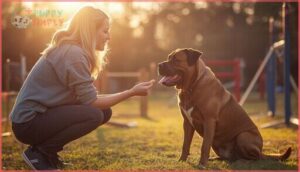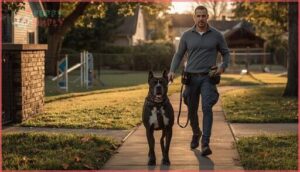This site is supported by our readers. We may earn a commission, at no cost to you, if you purchase through links.
A Chihuahua snarls and snaps at strangers with alarming frequency, yet rarely makes headlines. Meanwhile, a single incident involving a Pit Bull dominates news cycles for weeks. This disconnect reveals a critical truth: when we talk about aggressive dog breeds, we’re often conflating two separate issues—the frequency of aggressive behavior and the severity of potential harm.
Breed labels carry enormous weight in insurance policies, housing restrictions, and public perception, but the science tells a more nuanced story. Genetics, training history, environmental stressors, and yes, physical capabilities all shape canine aggression in ways that defy simple breed categorization.
Understanding which dogs present genuine risks, why certain breeds developed protective instincts, and how responsible ownership transforms outcomes isn’t just academic—it’s essential knowledge for anyone sharing space with dogs, whether you’re considering adoption, living in a neighborhood with dogs, or simply want to separate myth from evidence.
Table Of Contents
- Key Takeaways
- What Defines an Aggressive Dog Breed?
- Factors Influencing Canine Aggression
- Most Frequently Labeled Aggressive Breeds
- Dog Bite Statistics and Real-World Impact
- Training and Preventing Aggressive Behaviors
- Responsible Ownership of Aggressive Breeds
- Frequently Asked Questions (FAQs)
- What is the number one aggressive dog breed?
- Are any dog breeds naturally aggressive?
- What is the least aggressive dog?
- How to deal with an aggressive dog?
- How does diet influence canine aggression?
- What role does genetics play in aggression mitigation?
- Can spaying or neutering reduce aggression in dogs?
- How do dog shelters assess aggressive behavior?
- What are the legal implications of owning an aggressive breed?
- Can aggressive dogs ever be rehabilitated successfully?
- Conclusion
Key Takeaways
- Breed labels oversimplify aggression risk—genetics contribute less than 25% to aggressive behavior, while environment, socialization, and owner management shape over 75% of a dog’s actual conduct.
- Pit Bulls account for roughly 66% of fatal dog attacks despite representing a small fraction of the dog population, yet bite statistics conflate frequency of aggression (where small breeds like Chihuahuas lead) with severity of harm.
- Early socialization between 3-14 weeks reduces fear-based aggression by 50-70%, and positive reinforcement training combined with adequate exercise (90+ minutes daily for high-energy breeds) prevents most behavioral issues before they escalate.
- Breed-specific legislation costs millions to enforce without reducing bite rates, while behavior-based policies focusing on responsible ownership—including proper training, health monitoring, and owner accountability—prove far more effective at preventing dog attacks.
What Defines an Aggressive Dog Breed?
When people talk about “aggressive dog breeds,” they’re often mixing up genetics, behavior, and bite statistics in ways that blur the real picture. The truth is, no breed is born aggressive—but certain traits, histories, and physical capabilities do matter when evaluating risk.
Let’s break down what actually shapes a dog’s potential for aggression and where misconceptions cloud the facts.
Common Traits of Aggressive Breeds
When it comes to aggressive dog breeds, you’ll notice certain patterns emerge. Breed temperament isn’t about labeling—it’s about understanding breed-specific traits and characteristics that influence canine aggression. Some dogs display aggression signs like growling or snapping when threatened, while others possess powerful bite force that amplifies injury severity.
Key breed characteristics and traits include:
- Physical attributes: Canine body size and jaw strength directly impact attack patterns, with larger breeds causing more severe tissue damage
- Behavioral tendencies: Dog temperament varies—some breeds show territorial aggression, others resource guarding
- Trigger responses: Certain breeds react more intensely to environmental stressors, escalating from warning signals to biting faster
Understanding a dog’s bite force factors is vital in evaluating potential aggression.
Genetics and Breeding History
Your dog’s aggressive tendencies aren’t just about how they were raised—genetics play a powerful role. Breeding practices have shaped canine aggression for generations, with specific genetic markers like SLC6A4 and MAOA influencing neurotransmitter regulation. Heritability estimates for aggression genes range from 0.16 to 0.68, meaning breed characteristics and traits are partially hardwired.
Genetics partially hardwire aggression in dogs—specific markers influence behavior with heritability estimates ranging from 0.16 to 0.68
Understanding dog breeding and genetics helps you recognize why certain dog breeds and aggression connect. Research on dog breed genetics provides valuable insights into the genetic basis of canine behavior.
Misconceptions About Aggression
While genetics matter, the dominance theory—the idea that dogs seek to control you—has been thoroughly debunked by animal behavior experts. Real canine aggression stems from fear-based behavior, not a power play.
Confrontational training methods actually increase aggression by triggering defensive responses. Understanding canine psychology means recognizing that aggressive dog breeds aren’t plotting dominance—they’re reacting to anxiety, inadequate socialization, or misguided techniques that backfire.
Factors Influencing Canine Aggression
Aggression in dogs isn’t just about breed—it’s shaped by a mix of physical traits, mental wiring, and the world around them. Understanding these factors gives you real power to predict, prevent, and manage potential issues before they escalate.
Let’s break down what actually drives aggressive behavior in dogs.
Size, Strength, and Physical Attributes
You might assume all aggressive dog breeds share the same build, but physical traits vary dramatically. Rottweilers pack a 328 psi bite force with broad skulls and dense muscle structure, while Pitbulls deliver around 235 psi through stocky frames.
Consider these key factors:
- Jaw anatomy directly influences bite severity
- Muscle structure determines attack endurance
- Breed morphology affects injury potential
- Physical intimidation shapes public perception
These characteristics don’t guarantee aggression—they heighten consequences when it occurs.
Energy Levels and Exercise Needs
Surprisingly, high-energy breeds without adequate physical activity show markedly elevated aggression rates—over 99% of dogs display behavioral issues when exercise falls short. Daily exercise needs aren’t optional extras; they’re essential canine fitness requirements that directly regulate breed-specific energy level management, reducing stress hormones that trigger reactive dog behavior in aggressive dog breeds.
Your Jack Russell needs 1.5 to 2 hours daily, while Pitbulls and Rottweilers require similar commitments.
Territorial and Protective Instincts
Certain breeds carry ancient guarding genes—Rottweilers, German Shepherds, and Akitas developed territorial marking and protective behaviors through centuries of selective breeding. About 57% of dogs possess genetic variants tied to territoriality, but hormonal influences like testosterone greatly heighten these instincts. Understanding breed genetics helps you manage these powerful drives effectively:
- Intact males show 62% higher territorial aggression
- 15-20% of dogs display resource guarding behaviors
- Elevated cortisol doubles aggressive responses in territorial contexts
Environmental and Social Triggers
Nearly half of dogs nationwide wrestle with moderate to severe anxiety, and environmental stressors—noise pollution, crowding effects, and social isolation—directly fuel canine aggression and behavior problems. Your dog’s stress management hinges on environmental enrichment and proper dog socialization and training.
Consider these triggers carefully:
| Environmental Trigger | Aggression Impact |
|---|---|
| Loud noises, unfamiliar settings | Fear-based aggression (most common form) |
| Prolonged confinement, lack of enrichment | 55.6% show moderate-severe aggression |
| Social deprivation during development | Increased fear and aggression in adulthood |
Mastering aggression management means controlling your dog’s world—reducing stressors before aggressive dog breeds react.
Most Frequently Labeled Aggressive Breeds
When you hear “aggressive dog breed,” certain names come to mind more often than others. Some of these dogs earned their reputation through bite statistics and media coverage, while others are labeled aggressive simply because of their size, energy, or protective instincts.
Let’s look at the breeds most frequently called out for aggression—and what actually drives their behavior.
Chihuahuas and Small Breeds
You might be surprised to learn that Chihuahuas top the charts for aggressive behaviors—studies show small breeds are twice as likely to bite, growl, or snap compared to larger dogs. Their defensiveness often stems from fear and inadequate Puppy Socialization.
Understanding Canine Body Language and investing in proper Chihuahua Grooming routines, Small Dog Nutrition, and early training transforms these tiny companions into well-adjusted members of your family.
Jack Russell Terriers and High-Energy Dogs
Jack Russell Terriers pack outsized energy into compact frames—your JRT needs at least 90 minutes of daily exercise to prevent frustration-driven biting. When their exercise needs aren’t met, these high-energy breeds channel that intensity into destructive behaviors and aggression.
- Bred for hunting, they possess relentless prey drive and athletic stamina
- Boredom triggers anxiety, impulsivity, and difficulty controlling bite inhibition
- Mental stimulation through puzzle toys and training methods is equally critical
- Consistent routines combining physical activity and enrichment prevent behavioral escalation
Pitbulls, XL Bullies, and Strong-Jawed Breeds
American Pit Bull Terriers, American Bullies, and XL Bullies dominate conversations about aggressive dog breeds—and the statistics demand your attention. These muscular build powerhouses generate bite forces reaching 240 PSI, with Pit Bulls accounting for 66.9% of fatal attacks from 2005-2019.
Their guard instincts and protective nature, combined with breed legislation and escalating owner liability concerns, reflect legitimate public safety considerations requiring transparent examination.
Rottweilers and German Shepherds
Rottweilers and German Shepherds represent a different breed comparison—intelligent working dogs with bite forces exceeding 300 PSI. Rottweilers account for 10% of fatal attacks, while German Shepherds rank second in reported bites at 7.1%.
Aggression factors here aren’t about inherent viciousness—they’re linked to inadequate training methods, poor socialization, and health issues like epilepsy.
Responsible dog ownership transforms these protective guardians into reliable companions through early intervention and consistent bite prevention strategies.
Wolf/Dog Hybrids and Uncommon Breeds
Wolf-dog hybrids present the highest unpredictability factor, ranking sixth in dog bite fatalities despite their rarity. These crossbreeding risks stem from wild instincts that resist domestication: higher prey drive, fearfulness of humans, and independence that complicates aggression management.
Even “domesticated” uncommon breeds like Czechoslovakian Vlčaks retain genetic traits that demand specialized handling. You’re not just managing aggressive dog breeds—you’re traversing hybrid genetics that blur the line between pet and predator.
Dog Bite Statistics and Real-World Impact
The numbers tell a story that’s hard to ignore. Every year, millions of people experience dog bites, and while most incidents result in minor injuries, some leave lasting physical, emotional, and financial scars.
Here’s what the data reveals about the real-world impact of dog aggression.
Annual Dog Bite Incidence Rates
Every year, you’re looking at roughly 4.5 million dog bites across the U.S., with about 885,000 requiring medical attention. Fatal bite analysis shows an alarming jump—from 62 deaths in 2020 to 127 in 2024. Here’s what the incident reporting reveals:
| Bite Rate Trends | Impact |
|---|---|
| Total annual bites | ~4.5 million |
| Medical attention needed | 885,000 |
| Hospitalizations | 12,300 |
| Fatal dog attacks (2024) | 127 |
Understanding these dog attack statistics helps you recognize the scope of canine aggression and why dog bite prevention matters for your family’s safety.
Breeds Most Involved in Severe Attacks
When you look at fatal attack statistics, Pit Bulls account for roughly 66% of deaths, with Rottweilers contributing another 10%. German Shepherds also appear frequently in bite force analysis showing attack severity.
| Most Dangerous Dog Breeds | Fatal Involvement |
|---|---|
| Pit Bulls | 66% |
| Rottweilers | 10% |
| German Shepherds | Notable % |
| Mixed/Other | Remainder |
Breed legislation hasn’t markedly improved dog bite prevention outcomes.
Financial and Medical Consequences
The ripple effects of dog bites extend far beyond the initial wound. Medical expenses for bite victims range from $1,000 for emergency treatment to over $50,000 for reconstructive surgery. Insurance claims skyrocketed to $1.6 billion in 2024, while legal fees push settlement amounts between $58,500 and $125,000—costs that dramatically impact victim compensation and community healthcare resources.
| Cost Category | Typical Range |
|---|---|
| Emergency Care | $1,000–$5,000 |
| Reconstructive Surgery | $10,000–$50,000+ |
| Legal Settlements | $58,500–$125,000 |
| Insurance Premiums (Annual Increase) | 12.3%–42.9% |
| Total U.S. Claims (2024) | $1.6 billion |
Public Perception and Media Coverage
Media coverage significantly influences public perception of dangerous dog breeds, often in ways that diverge from reality. Sensational reporting tends to amplify fear, with Pit Bulls disproportionately featured in 66-76% of fatal attack stories, despite representing only a small fraction of all dogs. This media bias perpetuates breed stereotypes, leading to breed-specific legislation and social stigma that often overlook owner responsibility and environmental factors.
| Breed | Media Portrayal | Legislative Impact |
|---|---|---|
| Pit Bulls | 66-76% of fatal attack coverage | Banned in 700+ U.S. jurisdictions |
| Rottweilers | Frequent negative framing | Restricted ownership in 30+ countries |
| German Shepherds | Mixed coverage (police vs. attack) | Insurance policy exclusions common |
| Wolf Hybrids | Sensationalized as “wild” threats | Prohibited in 15 U.S. states |
| All Breeds | Positive stories underrepresented | Behavior-based laws emerging slowly |
Training and Preventing Aggressive Behaviors
You can’t rewrite a dog’s genetics, but you can absolutely shape how those instincts show up in daily life. Early intervention and consistent training make the difference between a dog that reacts and one that pauses to think.
Let’s look at the core strategies that help prevent aggression before it becomes a problem.
Importance of Early Socialization
Your puppy’s first few months are when their brain is most open to learning—especially between 3 and 14 weeks. This critical window for puppy socialization shapes canine development permanently.
Dogs exposed to people, sounds, and environments early show 50-70% less fear and over 60% fewer aggressive behaviors later.
Starting dog socialization at 7-8 weeks prevents fear-based reactions in aggressive dog breeds, building confidence that lasts a lifetime.
Positive Reinforcement Techniques
When you reward good behavior instead of punishing the bad, you’re using operant conditioning—a proven path to dog behavior modification. Positive reinforcement therapy works because it lowers stress and builds trust, reducing aggression by 30-50% in studies. This reward-based training approach transforms even challenging breeds.
- Treats and praise create instant connections between commands and compliance
- Clicker methods mark exact moments of good behavior for faster learning
- Play rewards engage high-drive dogs while strengthening your bond
Canine behavior and training experts consistently rank positive reinforcement as the most effective, humane strategy for aggressive dog breeds and safety.
Managing High-Energy and Territorial Breeds
High-energy and territorial breeds demand strategic breed selection upfront—then daily commitment. Your dog’s exercise needs aren’t optional; Border Collies and German Shepherds require 1.5-2 hours of vigorous activity to prevent destructive outbursts.
Combine physical outlets with canine enrichment like puzzle toys and scent games.
Territorial training through desensitization reduces aggressive incidents by 60%, especially when paired with environmental modifications and assertive leadership that establishes boundaries without confrontation.
Role of Spaying/Neutering in Aggression
Spaying and neutering don’t guarantee aggression prevention—the hormone impact is far more nuanced. Research shows spay effects vary wildly: some studies report up to 68% increased aggression toward strangers in spayed females, while neutering benefits include reduced roaming.
Behavioral changes depend on age, breed, and individual physiology. For aggressive dog breeds, consider timing carefully and discuss alternative sterilization methods with your vet.
Responsible Ownership of Aggressive Breeds
Owning a dog that’s labeled aggressive isn’t something you can take lightly—it requires genuine commitment, awareness, and a willingness to put in the work. You’ll need to understand the legal landscape, stay educated about your dog’s needs, and prioritize both your pet’s health and your community’s safety.
Here’s what responsible ownership really looks like when you’re caring for one of these breeds.
Breed-Specific Laws and Regulations
Across 54 countries, breed-specific legislation targets dogs like Pit Bulls through outright breed bans, mandatory insurance, or muzzling requirements. While these regulatory reforms aim to boost public safety, enforcement costs often exceed millions—Denver alone spent over $100 million—without reducing bite rates.
Legal challenges continue as evidence shows breed-specific legislation proves largely ineffective, prompting many jurisdictions to shift toward behavior-based policies emphasizing responsible pet ownership over targeting specific dog breed characteristics.
Owner Education and Accountability
Beyond legislation, responsible pet ownership starts with you. Studies show only 10% of owners complete formal dog training, yet structured owner education slashes aggressive behaviors by up to 50%.
Early dog socialization during puppyhood—paired with accountability measures like consistent positive reinforcement—builds calm, confident dogs.
When you invest in education programs and hands-on pet safety and responsibility practices, you’re not just preventing bites; you’re strengthening the bond between you and your companion.
Health Monitoring and Veterinary Care
Your veterinary checkups do more than keep vaccines current—they’re your first line of defense against aggression rooted in pain or illness. Diagnostic testing catches neurological disorders, hormonal imbalances, and chronic pain early, reducing aggression incidents by nearly 79% when paired with medical interventions. Preventative care transforms dog care and wellbeing: routine health screenings detect issues before they escalate, protecting both your pet and your community.
Here’s how to implement this approach:
- Schedule veterinary medicine exams every 6–12 months
- Request blood panels to identify hormonal or metabolic triggers
- Monitor dental health—toothaches fuel defensive biting
- Address parasites and infections promptly
- Combine medication with behavioral therapy for lasting results
Community Safety and Ethical Considerations
Your moral obligations extend beyond your property line. When community safety meets ethical ownership, you’re balancing public awareness with animal welfare—a tightrope that demands both community engagement and honest self-assessment.
Safety measures like secure fencing and leash protocols protect neighbors, while breed-specific legislation debates remind you that responsible pet care transcends personal freedom.
Your choices ripple outward, shaping how aggressive dog breeds coexist with the people around you.
Frequently Asked Questions (FAQs)
What is the number one aggressive dog breed?
Like choosing a gladiator, pinpointing the “number one” aggressive dog breed isn’t simple.
Data shows Pitbulls dominate fatal dog attacks—causing roughly 66% of bite fatalities—making them statistically the most dangerous breed documented.
Are any dog breeds naturally aggressive?
No dog breed is hardwired for aggression from birth. Genetics contributes less than 25% to aggressive tendencies, while environment, socialization, and owner management shape over 75% of canine behavior patterns.
What is the least aggressive dog?
Golden Retrievers, Labrador Retrievers, and Cavalier King Charles Spaniels consistently rank among the least aggressive dog breeds.
These gentle giants and calm breeds exhibit friendly dogs’ temperament—low risk profiles shaped by genetics favoring non aggressive, sociable behavior in pet care and safety contexts.
How to deal with an aggressive dog?
First, you’ll want to recognize aggression signs like stiff posture or growling.
Stay calm, avoid direct eye contact, and use calming techniques.
Deescalation methods and safety precautions protect everyone while addressing the behavior.
How does diet influence canine aggression?
Your dog’s meals shape more than just health—nutrient deficiencies, blood sugar control, omega-3 effects, and macronutrient ratios directly influence mood stability, impulsivity, and aggression management across all canine aggression and breed-specific traits.
What role does genetics play in aggression mitigation?
You can’t rewrite your dog’s DNA, but genetic research shows that environmental influence—socialization, training, and proper management—shapes how breed characteristics and genetic predisposition translate into real-world canine aggression and behavior.
Can spaying or neutering reduce aggression in dogs?
Yes—spaying benefits include calmer territorial behavior, while neutering effects show over 60% reduction in inter-male aggression. However, fear-based behavioral changes vary individually, so surgical impact alone won’t replace proper training for aggression management and prevention.
How do dog shelters assess aggressive behavior?
Shelters use behavioral testing protocols like ASPCA SAFER to evaluate dog behavior through handling, resource guarding, and social interaction assessments.
These shelter environment evaluations help identify aggression management needs, though predictive accuracy remains limited.
What are the legal implications of owning an aggressive breed?
You could face strict liability for bites, breed-specific bans, mandatory insurance, or even ownership prohibitions. Legal reforms increasingly hold owners accountable—responsible ownership means understanding breed-specific legislation before you bring a dog home.
Can aggressive dogs ever be rehabilitated successfully?
Rehabilitation through behavioral therapy and training can transform many dogs, with structured programs showing 68-80% success rates.
Your commitment to counter-conditioning, desensitization, and sometimes medication makes lasting change possible, especially with early intervention.
Conclusion
A well-trained Rottweiler can navigate a crowded park with calm confidence, while an undersocialized Golden Retriever becomes a liability—breed alone never tells the full story.
Your commitment to understanding canine behavior, recognizing warning signs, and investing in proper socialization determines outcomes far more than any label.
Aggressive dog breeds exist on paper, but responsible owners create safe dogs in practice. The leash you hold carries more power than the genetics behind it.
- https://www.advancedbackandneckcare.com/dog-attacks-by-breed-2024-dog-bite-statistics-state-fatality-data
- https://www.avma.org/sites/default/files/resources/dog_bite_risk_and_prevention_bgnd.pdf
- https://stacks.cdc.gov/view/cdc/66184
- https://curtislegalgroup.com/blog/15-most-dangerous-dog-breeds-weight-and-bite-force
- https://www.pitbullhero.org/dog-bite-studies

